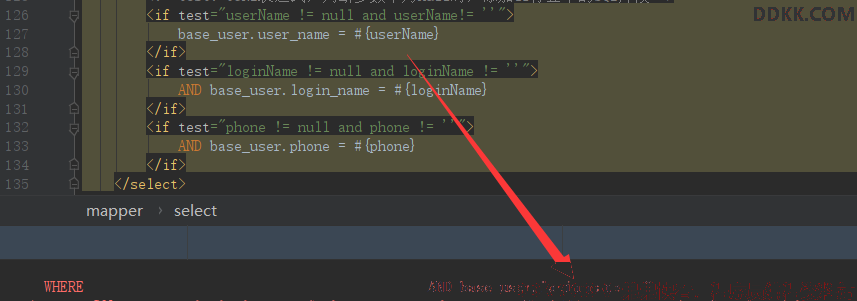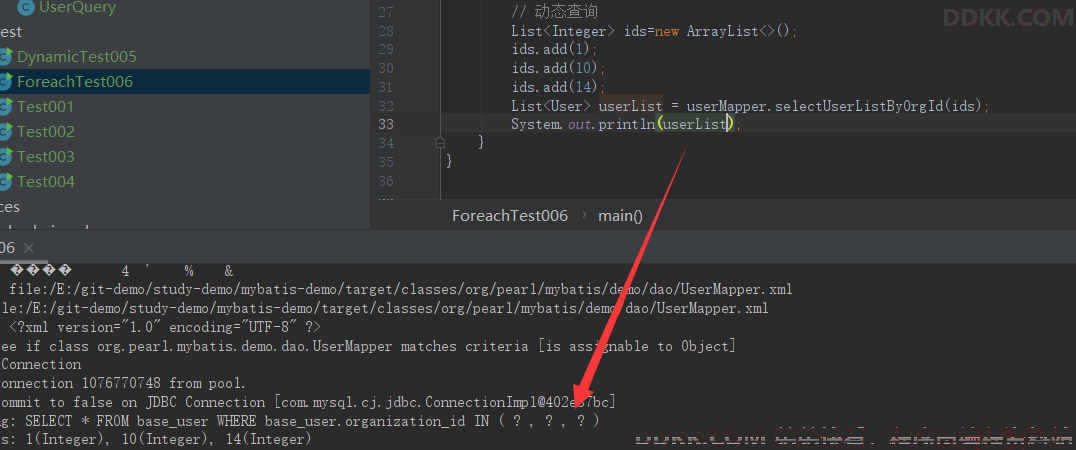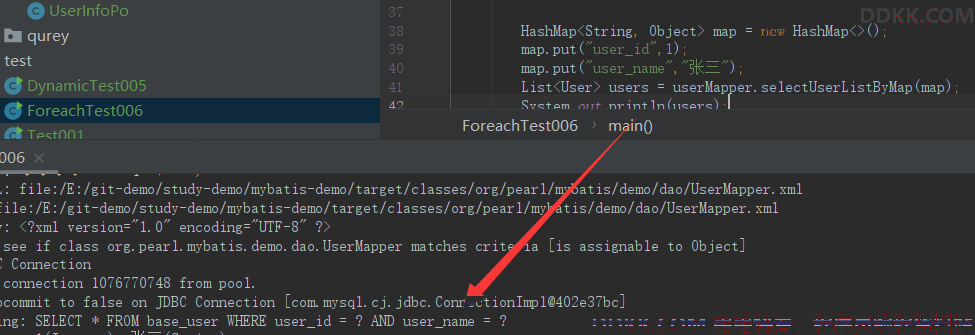06、MyBatis源码 - Mapper映射文件详解之动态SQL
动态 SQL
所谓动态 SQL就是根据用户输入参数等才能确定的语句,根据用户输入参数执行不同的增删改查。
动态SQL 是 MyBatis 的强大特性之一。如果你使用过 JDBC 或其它类似的框架,你应该能理解根据不同条件拼接 SQL 语句有多痛苦,例如拼接时要确保不能忘记添加必要的空格,还要注意去掉列表最后一个列名的逗号。利用动态 SQL,可以彻底摆脱这种痛苦。
使用动态 SQL 并非一件易事,但借助可用于任何 SQL 映射语句中的强大的动态 SQL 语言,MyBatis 显著地提升了这一特性的易用性。
如果你之前用过 JSTL 或任何基于类 XML 语言的文本处理器,你对动态 SQL 元素可能会感觉似曾相识。在 MyBatis 之前的版本中,需要花时间了解大量的元素。借助功能强大的基于 OGNL 的表达式,MyBatis 3 替换了之前的大部分元素,大大精简了元素种类,现在要学习的元素种类比原来的一半还要少。
- if
- choose (when, otherwise)
- trim (where, set)
- foreach
if
使用if条件可以对参数进行判断,当结果为真时,再把某个条件拼接到SQL中,可以实现根据参数生成动态SQL的功能。
简单案例
根据用户姓名、登录账号、手机参数,动态的查询用户列表。
1、 创建用户查询对象;
@Data
public class UserQuery {
private String userName;
// 姓名模糊查询
private String userName_like;
private String loginName;
private String phone;
private String email;
}
1、 创建动态SQL;
// 根据查询参数动态查询用户列表
List<User> selectDynamicUserList(UserQuery userQuery);
<select id="selectDynamicUserList" resultType="org.pearl.mybatis.demo.pojo.entity.User">
SELECT
*
FROM
base_user
WHERE
<!--test: OGNL表达式,判断参数不为null时,添加if标签中的SQL片段-->
<if test="userName != null">
base_user.user_name ={userName}
</if>
<if test="loginName != null">
AND base_user.login_name ={loginName}
</if>
<if test="phone != null">
AND base_user.phone ={phone}
</if>
</select>
1、 执行查询,不同的参数会构建不同的SQL;
// 动态查询
UserQuery userQuery=new UserQuery();
userQuery.setUserName("张巍");
//userQuery.setLoginName("zhangwei");
List<User> dynamicUserList = userMapper.selectDynamicUserList(userQuery);
System.out.println(dynamicUserList);
OGNL
官方文档
对象导航图语言(Object Graph Navigation Language),简称OGNL,是应用于Java中的一个开源的表达式语言(Expression Language),它被集成在Struts2、Mybatis等框架中,作用是对数据进行访问,它拥有类型转换、访问对象方法、操作集合对象等功能。
在MyBatis 中常见的 OGNL 表达式如下:
取值:
| 使用 | 描述 |
|---|---|
| e.property | 访问属性值 |
| e.method(args) | 调用对象方法 |
| e1[e2] | 访问数组、链表(e2 为序号)或者 Map(e2 为键值) |
逻辑运算:
| 使用 | 描述 |
|---|---|
| e1 or e2 | 或关系 |
| e1 and e2 | 与关系 |
| e1 == e2 或者 e1 eq e2 | 相等 |
| e1 != e2 或者 e1 neq e2 | 不等 |
| e1 lt e2 ;e1 < e2;e1 gt e2;e1 > e2;e1 lte e2;e1 <= e2;e1 gte e2;e1 >= e2 | 比较关系 |
| e1 + e2;e1 – e2;e1 * e2;e1 / e2;e1 % e2 | 运算关系 |
| !e 或者 not e | 非,取反 |
之前的xml可以优化为:
<select id="selectDynamicUserList" resultType="org.pearl.mybatis.demo.pojo.entity.User">
SELECT
*
FROM
base_user
WHERE
<!--test: OGNL表达式,判断参数不为null时,添加if标签中的SQL片段-->
<if test="userName != null and userName!= ''">
base_user.user_name ={userName}
</if>
<if test="loginName != null and loginName != ''">
AND base_user.login_name ={loginName}
</if>
<if test="phone != null and phone != ''">
AND base_user.phone ={phone}
</if>
</select>
choose (when, otherwise)
有时候,我们不想使用所有的条件,而只是想从多个条件中选择一个使用。针对这种情况,MyBatis 提供了 choose 元素,它有点像 Java 中的 switch 语句。
使用案例: 传入了ID,就用id查,传入了账号,就只用账号查,没有ID也没有账号,就用电话查
<select id="selectDynamicUserList" resultType="org.pearl.mybatis.demo.pojo.entity.User">
SELECT
*
FROM
base_user
WHERE
<choose>
<when test="userId != null and userId!= ''">
base_user.user_id ={ userId}
</when>
<when test="loginName != null and loginName!= ''">
base_user.login_name ={ loginName}
</when>
<otherwise>
base_user.phone ={ phone}
</otherwise>
</choose>
</select>
where、trim、set
where
之前if标签使用的案例中,会存在某些问题,比如userName为空,WHERE 之后直接拼接AND ,会出现SQL语法错误:

where 元素只会在子元素返回内容的情况下才插入 “WHERE” 子句。而且,若子句的开头为 “AND” 或 “OR”,where 元素也会将它们去除。那么where 就能解决if出现的上述问题。
<select id="selectDynamicUserList" resultType="org.pearl.mybatis.demo.pojo.entity.User">
SELECT
*
FROM
base_user
<!--test: OGNL表达式,判断参数不为null时,添加if标签中的SQL片段-->
<where>
<if test="userName != null and userName!= ''">
base_user.user_name ={userName}
</if>
<if test="loginName != null and loginName != ''">
AND base_user.login_name ={loginName}
</if>
<if test="phone != null and phone != ''">
AND base_user.phone ={phone}
</if>
</where>
</select>
trim
如果where 元素与你期望的不太一样,你也可以通过自定义 trim 元素来定制 where 元素的功能。
trim 标签属性:
| 属性 | 功能描述 |
|---|---|
| prefix | 前缀属性,若标签内不为空则在 SQL 中添加上前缀 |
| prefixOverrides | 前缀覆盖属性,若标签中有多余的前缀,将会被覆盖(其实就是丢弃该前缀) |
| suffix | 后缀属性,若标签内不为空则在 SQL 中添加上后缀 |
| suffixOverrides | 后缀覆盖属性,若标签中有多余的后缀,将会被覆盖(其实就是丢弃该后缀) |
比如,和 where 元素等价的自定义 trim 元素为:
<trim prefix="WHERE" prefixOverrides="AND |OR ">
...
</trim>
上述语句的意思为,如果trim标签下生成的SQL片段不为空,则会添加WHERE关键字,如果存在多余的AND 或者OR怎会被删除。
set
用于动态更新语句的类似trim解决方案叫做 set。set 元素可以用于动态包含需要更新的列,忽略其它不更新的列。比如:
<update id="updateAuthorIfNecessary">
update Author
<set>
<if test="username != null">username=#{username},</if>
<if test="password != null">password=#{password},</if>
<if test="email != null">email=#{email},</if>
<if test="bio != null">bio=#{bio}</if>
</set>
where id=#{id}
</update>
这个例子中,set 元素会动态地在行首插入 SET 关键字,并会删掉额外的逗号(这些逗号是在使用条件语句给列赋值时引入的)。
来看看与 set 元素等价的自定义 trim 元素吧:
<trim prefix="SET" suffixOverrides=",">
...
</trim>
foreach
在MyBatis 中,常常会遇到集合类型的参数,虽然我们可以通过 OGNL 表达式来访问集合的某一个元素,但是 OGNL 表达式无法遍历集合。foreach 标签用来遍历数组、列表和 Map 等集合参数,常与 in 关键字搭配使用。
foreach 元素的功能非常强大,它允许你指定一个集合,声明可以在元素体内使用的集合项(item)和索引(index)变量。它也允许你指定开头与结尾的字符串以及集合项迭代之间的分隔符。这个元素也不会错误地添加多余的分隔符。
你可以将任何可迭代对象(如 List、Set 等)、Map 对象或者数组对象作为集合参数传递给 foreach。当使用可迭代对象或者数组时,index 是当前迭代的序号,item 的值是本次迭代获取到的元素。当使用 Map 对象(或者 Map.Entry 对象的集合)时,index 是键,item 是值。
foreach 标签属性:
| 标签 | 说明 |
|---|---|
| collection | 被遍历集合参数的名称,如 list; |
| open | 遍历开始时插入到 SQL 中的字符串,如 ( ; |
| close | 遍历结束时插入到 SQL 中的字符串,如 ) ; |
| separator | 分割符,在每个元素的后面都会插入分割符; |
| item | 元素值,遍历集合时元素的值; |
| index | 元素序列,遍历集合时元素的序列。 |
(1)遍历List
1、 接口;
// 查询某些机构下的用户
List<User> selectUserListByOrgId(List<Integer> ids);
1、 xml;
<select id="selectUserListByOrgId" resultType="org.pearl.mybatis.demo.pojo.entity.User">
SELECT
*
FROM
base_user
WHERE base_user.organization_id IN
<foreach collection="list" open="(" close=")" separator="," item="item" index="index">
{item}
</foreach>
</select>
1、 SQL;

(2)遍历数组
如果ids 参数使用 @Param 注解指定了参数名称,则 foreach 标签中的 collection 属性必须为该名称;但若未指定名称,则在 foreach 标签中使用默认数组名称 array。
<select id="selectUserListByOrgId" resultType="org.pearl.mybatis.demo.pojo.entity.User">
SELECT
*
FROM
base_user
WHERE base_user.organization_id IN
<foreach collection="array" open="(" close=")" separator="," item="item" index="index">
{item}
</foreach>
</select>
(3)遍历Map
使用 foreach 标签遍历 Map 时,collection 属性值为注解@Param指定的参数名,且 item 是 Map 的键值,index 是键名。由于 key 是字段名称,因此不能使用#{}作为占位符,只能使用${}在字符串中替换。
// 根据Map查询用户列表
List<User> selectUserListByMap(@Param("maps") Map<String,Object> maps);
<select id="selectUserListByMap" resultType="org.pearl.mybatis.demo.pojo.entity.User">
SELECT
*
FROM
base_user
WHERE
<foreach collection="maps" item="val" index="key" separator="AND">
${key} ={val}
</foreach>
</select>

(4)批量保存
批量保存是一个常用操作,比如Mybatis Plus提供了insertBatch()方法,但是其本质还是循环插入,在Mybatis中,foreach也可用来执行批量保存操作,单条语句一次插入多条数据。
原生SQL:
INSERT INTO base_user ( user_name, login_name ) VALUES
( "aaa", "aaaa" ),
( "bbb", "bbbb" );
Mybatis:
int insertBatch(List<User> userList);
<insert id="insertBatch">
INSERT INTO base_user ( user_name, login_name ) VALUES
<foreach collection="list" item="user" separator=",">
(#{user.userName},{user.loginName})
</foreach>
</insert>

注意事项:
- 批量保存如果拆分成多个SQL,使用;分割时,Mysql数据库连接参数需要添加“allowMultiQueries=true”开启多语句执行。
- Oracle时不支持以上使用方式,可以使用begin、end或者中间表或其他方式插入。
script
要在带注解的映射器接口类中使用动态 SQL,可以使用 script 元素。但是这种方式确实不太美观,一般不推荐使用,比如:
@Update({"<script>",
"update Author",
" <set>",
" <if test='username != null'>username=#{username},</if>",
" <if test='password != null'>password=#{password},</if>",
" <if test='email != null'>email=#{email},</if>",
" <if test='bio != null'>bio=#{bio}</if>",
" </set>",
"where id=#{id}",
"</script>"})
void updateAuthorValues(Author author);
bind
bind 标签可以使用 OGNL 表达式创建一个变量井将其绑定到上下文中。
bind属性列表:
| 属性 | 说明 |
|---|---|
| name | 绑定到上下文的变量名 |
| value | OGNL 表达式 |
在进行模糊查询时,使用‘%#{}%会报错,如果使用“${}”拼接字符串,则无法防止 SQL 注入问题。如果使用字符串拼接函数或连接符号,但不同数据库的拼接函数或连接符号不同。bind标签可以绑定%到查询参数中,然后再赋值给name参数,再在SQL中引用此变量。
<!--使用bind元素进行模糊查询-->
<select id="selectUserByBind" resultType="com.po.MyUser" parameterType= "com.po.MyUser">
<!-- bind 中的 uname 是 com.po.MyUser 的属性名-->
<bind name="paran_uname" value="'%' + uname + '%'"/>
select * from user where uname like{paran_uname}
</select>
内置参数(_databaseId、_parameter)
mapper接口除了传过来的参数可以取值判断外,还提供了两个内置参数(_parameter 、_databaseId )使用。
_databaseId
如果配置了databaseIdProvider标签, _databaseId就是代表当前数据库的别名,mysql或者oracle等等。就可以在动态代码中使用名为 “_databaseId” 的变量来为不同的数据库构建特定的语句。
<insert id="insert">
<selectKey keyProperty="id" resultType="int" order="BEFORE">
<if test="_databaseId == 'oracle'">
select seq_users.nextval from dual
</if>
<if test="_databaseId == 'db2'">
select nextval for seq_users from sysibm.sysdummy1"
</if>
</selectKey>
insert into users values (#{id},{name})
</insert>
_parameter
_parameter 代表整个参数:
- 单个参数,_parameter 就是这个参数
- 多个参数 会被封装成一个map,_parameter就是代表这个map
<select id="getEmpByDataBaseId" resultType="emp">
<if test="_databaseId=='mysql'">
select * from employee
<if test="_parameter!=null">
where last_name=#{_parameter.lastName}
</if>
</if>
<if test="_databaseId=='oracle'">
select * from employees_tbl
</if>
</select>